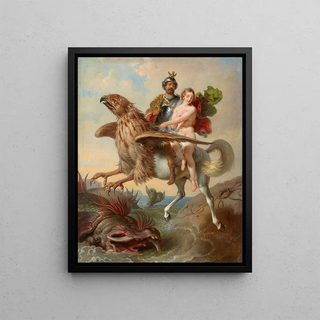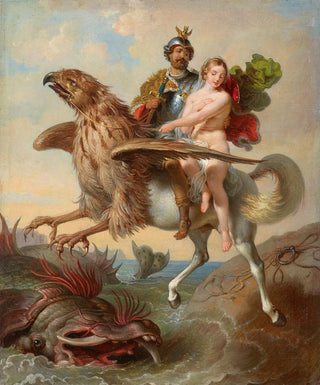Art print | Rüdiger and Angelica - Johann Peter Krafft


View from behind

Frame (optional)
In the vast panorama of art history, some works stand out for their ability to evoke timeless stories and profound emotions. "Rüdiger and Angelica" by Johann Peter Krafft is one of those creations that transcend eras. This painting, imbued with romantic sensitivity, immerses us in a universe where love and sacrifice meet, illustrating a poignant scene from the medieval epic. The characters, Rüdiger, noble knight, and Angelica, beautiful and gentle, capture the essence of human passions while revealing the dramatic tensions of their time. By contemplating this work, the viewer is invited to feel the pain and beauty of a thwarted love, a universal theme that still resonates today.
Style and uniqueness of the work
Johann Peter Krafft's style is characterized by an impressive mastery of color and light, elements that breathe palpable life into his compositions. In "Rüdiger and Angelica," warm tones and delicate shadows create an atmosphere that is both intimate and dramatic. Krafft excels in rendering facial expressions; each gaze and gesture of the characters tell a story beyond words. The meticulous detail with which he depicts costumes and backgrounds demonstrates a deep respect for historical authenticity, while aligning with a romantic tradition that values emotion over reason. The work unfolds like a narrative tableau, where each visual element contributes to the plot, inviting the viewer to immerse themselves in this scene charged with feelings.
The artist and his influence
Johann Peter Krafft, Austrian painter of the early 19th century, made his mark by adopting an innovative approach to historical painting. Trained within the context of classicism, he quickly turned toward romanticism, seeking to express deep emotions and universal themes through his art. Krafft was influenced by the great masters of painting but developed a personal style that combines academic rigor with romantic sensitivity. By exploring historical and mythological subjects,

Matte finish

View from behind

Frame (optional)
In the vast panorama of art history, some works stand out for their ability to evoke timeless stories and profound emotions. "Rüdiger and Angelica" by Johann Peter Krafft is one of those creations that transcend eras. This painting, imbued with romantic sensitivity, immerses us in a universe where love and sacrifice meet, illustrating a poignant scene from the medieval epic. The characters, Rüdiger, noble knight, and Angelica, beautiful and gentle, capture the essence of human passions while revealing the dramatic tensions of their time. By contemplating this work, the viewer is invited to feel the pain and beauty of a thwarted love, a universal theme that still resonates today.
Style and uniqueness of the work
Johann Peter Krafft's style is characterized by an impressive mastery of color and light, elements that breathe palpable life into his compositions. In "Rüdiger and Angelica," warm tones and delicate shadows create an atmosphere that is both intimate and dramatic. Krafft excels in rendering facial expressions; each gaze and gesture of the characters tell a story beyond words. The meticulous detail with which he depicts costumes and backgrounds demonstrates a deep respect for historical authenticity, while aligning with a romantic tradition that values emotion over reason. The work unfolds like a narrative tableau, where each visual element contributes to the plot, inviting the viewer to immerse themselves in this scene charged with feelings.
The artist and his influence
Johann Peter Krafft, Austrian painter of the early 19th century, made his mark by adopting an innovative approach to historical painting. Trained within the context of classicism, he quickly turned toward romanticism, seeking to express deep emotions and universal themes through his art. Krafft was influenced by the great masters of painting but developed a personal style that combines academic rigor with romantic sensitivity. By exploring historical and mythological subjects,






